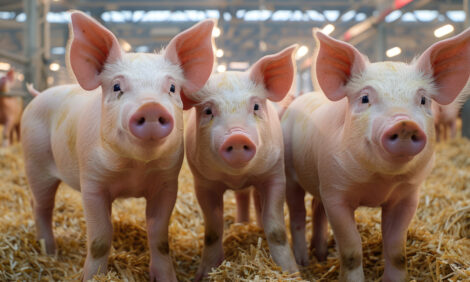



KSU Swine Day 2006: Porcine Umbilical Cord Matrix Stem Cells
By R. Carlin, D. Troyer, M. Weiss, B. Schultz, and D. Davis - This article is a collection of papers presented during KSU's Swine Day 2006. |
Summary
Since their discovery in 2000, pig umbilical cord stem cells have been studied at KState. The studies have been expanded to included other species, including humans. In addition, other research groups around the world have published scientific studies with these cells. Their unique attributes include being plentiful, easily collected, and (in humans) non-controversial. Initial work in the pig has concentrated on characterizing the cells to understand how they compare with other populations of stem cells. Results indicate that they have several characteristics in common with other primitive stem-cell populations, and that they are relatively easy to work with in the laboratory.
Introduction
The goal of the stem-cell group at K-State is to integrate education and commercialization with research on umbilical cord and related stem cells in humans and with research on umbilical cord stem cells and other stemcell sources in agricultural, companion, and competitive animals. The pig is currently the primary agricultural animal subject. Umbilical cord matrix stem cells (UCMSC) were first isolated from Wharton’s jelly in pig umbilical cords in 2000 in K-State laboratories. These cells have been shown be abundant, easily isolated and grown in vitro, and potentially valuable in clinical medicine.
Less recognized is their potential for cell-based technologies in animals, including agriculturally important species. Their large numbers and ease of collection open possibilities not previously considered. Their discovery is timely because the applications of knowledge of the genome will require cells for applications in animals and humans. The stem-cell group at K-State is small, but is establishing a record of scientific accomplishment. A major step was establishment of the Midwest Institute for Comparative Stem Cell Biology in the fall of 2005
(http://www.vet.ksu.edu/research/stemcell/ind ex.htm). Some information on the initial
characterization of pig UCMSC is presented herein.
Procedures
Three key regulators of gene transcription in mouse and human embryonic stem cells are Nanog, Oct-4, and Sox-2. These transcription factors regulate the expression of other genes during embryonic development. Downregulation of these three transcription factors is thought to be key for the loss of pluripotency and self-renewal, and for the beginning of subsequent differentiation. For this reason, we studied the expression of these transcription factors in porcine UCMSC.
Cells were isolated from Wharton's jelly of porcine umbilical cords and were histochemically assayed for the presence of alkaline phosphatase. Reverse-transcriptase polymerase- chain reaction (RT-PCR) assays were used to study expression of Nanog, Oct-4, and Sox- 2 genes. The synthesis of Oct-4 and Nanog protein was analyzed by using immunocytochemistry, and fluorescence-activated cellsorting (FACS) analysis was used to evaluate Hoechst 33342 dye-stained cells. Many stemcell populations have the ability to exclude this dye.
Results and Discussion
Porcine UCMSC isolates were maintained in culture and formed colonies of cells that expressed alkaline phosphatase, a marker of primitive stem cells. The FACS analysis revealed a side population of Hoechst dyeexcluding cells. Quantitative and nonquantitative RT-PCR reactions revealed expression of Nanog, Oct-4, and Sox-2 in d 15 embryonic discs, porcine UCMSC cell isolates, and porcine fibroblasts. Immunocytochemical analysis detected Nanog immunoreactivity in PUC cell nuclei, and detected faint labeling in fibroblasts. Oct-4 immunoreactivity was detected in the nuclei of some PUC cells, but not in fibroblasts.
Therefore, cells isolated from pig umbilical cord matrix express transcription factors considered to be pluripotent stem-cell markers, both at the mRNA and protein level. The presence of these transcription factors, along with the other characteristics of pig UCMSC, such as their colony-forming ability, Hoechst dye-excluding side population, and alkaline phosphatase expression, suggests that UCMSC have properties of primitive pluripotent stem cells. Furthermore, UCMSC are an easily and inexpensively obtained source of stem cells that are not hampered by the ethical or legal issues associated with human embryonic stem cells. In addition, these cells can be stored frozen in liquid N2 and are viable and grow in culture after thawing. This area of biotechnology in agricultural animals is in it’s infancy, but stem cells eventually may provide tools to enhance food safety, prevent/treat disease, enhance reproduction, improve carcass characteristics, and increase growth rate and feed efficiency in pigs and other agricultural animals.
Further Information
To view the summary page and the other articles in this series, click here
November 2006








